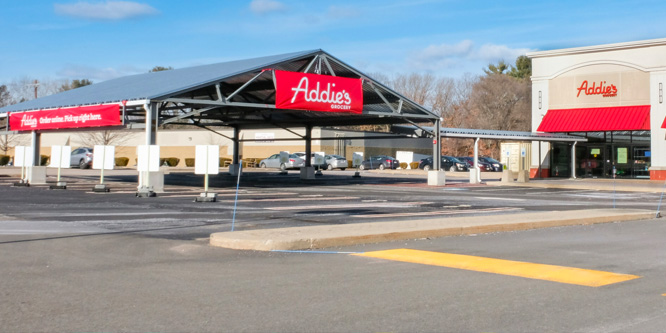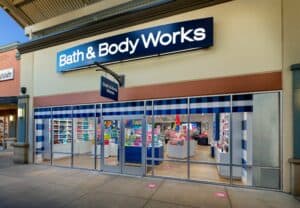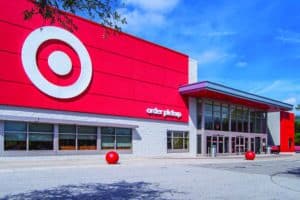
Addie’s is launching pickup only locations at a time when Walmart is closing similar concepts – Photo: Addie’s
February 9, 2023
What do Walmart closings say about the viability of pickup-only grocery stores?
Walmart is closing its two pickup- and delivery-only concept stores in the Chicago suburb of Lincolnwood and in Bentonville, AR.
Walmart opened the Lincolnwood store in 2019 on the site of a former Dominick’s Finer Foods supermarket. The store at 41,700 square feet was significantly larger than other pickup and delivery locations opened in recent years by the retailer in Bentonville and Metairie, LA.
Customers at the Lincolnwood store placed grocery orders through Walmart’s website or mobile app and arrived at an assigned canopied bay in the parking lot at the specified time to pick up their purchases.
Walmart spokesperson Felicia McCranie said the decisions to close the store in Lincolnwood and two others in the Chicagoland area were made after a “thorough review process,” which found that they had not performed up to the company’s expectations.
“We are grateful to the customers who have given us the privilege of serving them at our Lincolnwood location,” Ms. McCranie said in a statement.
Walmart’s decision, however, is not likely to dissuade startups pursuing a similar approach.
Addie’s recently opened its first pickup-only grocery concept store in Massachusetts after receiving $10.1 million in seed funding. The 22,000-square-foot store in Norwood opened on Jan. 26.
The company points to the expected growth in online ordering, unprofitable delivery models and the inadequacies of current pickup models as playing in its favor as it enters the market.
Addie’s says it took a zero-based approach to reimagine grocery operations, including inventory management and store and parking lot layouts, to improve efficiency and the customer experience at the same time. The company boasts a $20 starting wage for associates while claiming to offer attractive pricing for its customers.
“We believe that taking better care of busy families should be done in a way that also takes care of our team, our community and our planet,” said Jim McQuade, co-founder and CEO of Addie’s, in a statement. “With our seed funding, we’ve built an end-to-end experience to serve people in and around Norwood in a way that can be replicated in suburbs nationwide. We look forward to quickly expanding, offering busy families across the country drive-up grocery convenience without compromise.”
- Walmart to close three suburban stores, including pickup-only prototype in Lincolnwood – Chicago Tribune
- Walmart expands test of pickup-only grocery store concept – RetailWire
- Addie’s Debuts as the East Coast’s First Drive-up Grocer, with Rapid Expansion to Follow – Addie’s Grocery/PRNewswire
- Is curbside pickup-only grocery a viable business model? – RetailWire
- Online grocery shopping is pretty much all about convenience – RetailWire
Discussion Questions
DISCUSSION QUESTIONS: What do Walmart’s store closings and new store openings from startups like Addie’s say about the viability of pickup-only grocery stores? What do you see as the keys to making pickup-only models work?
Poll
BrainTrust
Dion Kenney
COO, Mondofora
John Karolefski
Editor-in-Chief, CPGmatters
Ananda Chakravarty
Vice President, Research at IDC
Recent Discussions








Just because it doesn’t work for Walmart doesn’t mean it’s a bad idea. There are many reasons for why Walmart decided to discontinue this offering, but it ultimately comes down to the fact that these stores were not delivering the outcomes expected. Full stop. I believe there still is a market for pickup-only players like Addie’s, and so Walmart’s decision should have no bearing on Addie’s or others.
Pickup-only retail locations are too limited to be useful. By contrast, BOPAC at full-service locations is good because, should something be wrong with an order or the customer needs additional items, they could walk into the same store and purchase the rest. For start-ups trying the pickup-only model, it may work in some categories, however food is not one them.
During the pandemic yes this worked, but while there is a niche that doesn’t want to talk to anyone and find some kind of value in driving to the store and waiting, most are not like this. Just because VC money pours in doesn’t mean there is enough profitable demand.
Bob, I agree with your point about VC money — raising money is often used as a proxy for “success” when in fact, VC’s record on retail investments is overall pretty bad. Just because you convince VCs you have a good idea, doesn’t mean it actually is.
BOPIS may not be dead, but it doesn’t yet have enough consumer acceptance to make it a viable standalone fulfillment strategy. Will it ever? Possibly, but the change in consumer behavior may be slower than retailers’ ability to change operational models.
Color me skeptical that the pickup-only model is sustainable. While I suspect the size of Walmart’s 47,000 square-foot space in Illinois may have been part of the problem, I just don’t know that locking shoppers out of the in-store aisles is a smart move. To work, the pickup-only stores need to be located close to their target shoppers, which by definition implies higher rent spaces. So if I am paying retail rent but then shutting out retail shoppers, that puts an awful lot of pressure on the marketing of the pickup option. It seems to me there are better ways to tackle the pickup profitability problem than by eliminating a big part of the revenue side of the equation. If it were me, I’d focus instead on process efficiencies and pricing for pickup and delivery services being offered within the context of full-service retail stores that are open to shoppers.
I agree completely. I don’t think this one-size-fits-all model can last.
Two thumbs up for Addie’s! I love to see new companies get into the mix. If they’ve done an excellent job of re-imagining the pickup business, there’s no reason it can’t succeed. I’m rooting for them! As for Walmart, this is business as usual for them. When they start a new initiative, they place targets on it and if they don’t hit the targets within a reasonable time frame (usually one to two years), they course correct and try again, or shutter it completely. This is their MO.
The convenience of pickup and/or delivery is still valid. Just because a major retailer like Walmart doesn’t find it fits into their system, doesn’t mean it’s a bad idea. There may be more to the Walmart store closings. I predict we’ll see more retailers adopt the pickup and delivery model. It will sit nicely alongside traditional retail.
I’m a bit surprised by this. The demand for these services remains strong, albeit not at the levels it was during the pandemic. I agree with Bob that the stores are limited in function. I also suspect that as Walmart and others have become better at curbside capabilities, they’ve found they can manage the services from existing stores and may not need drive-up-only facilities. I’m also curious if Walmart+, which offers free delivery for only $50 a year, isn’t also reducing demand for drive-up. I would suspect the overlap between customers who use drive-up and those who switch to delivery is large.
The keys to making this work from the customer perspective in my opinion are order accuracy and fill rate, managing wait times at the store, and order thresholds or cost of pickup. From the retailers’ perspective they are reduced handling and managing costs and inventory. As they improve in these capabilities, there is less and less justification for fulfillment-only centers.
Walmart is more than a grocer. Consumers may prefer to shop in Walmart stores for their cross-category needs, as well as to pick their own food. By contrast, Addie’s focuses on a narrow niche of convenience-oriented grocery targeting time-starved suburban families.
Reliable quality, freshness, availability and efficiency are keys to making pickup-only models work.
All great points, Lisa. Walmart’s targeted audience may also not be the best audience for BOPIS service. I haven’t yet seen a study of the demographics/psychographics of BOPIS shoppers, but my guess it is the mid- and upper-end shoppers for whom efficient use of time — particularly for buying commodity, shelf-stable products — is most important.
I’m going to interpret the problem here to be the word “only.” As a shopper I would not want to do my pickup shopping in one location and my in-store shopping in another location. I would find that to be cumbersome and inefficient. Give me one location where I can shop in-store when I need to and do a drive-thru pick-up when I want to.
Pickup-only grocery stores serve a few very specific segments of people: Mature consumers with health concerns, those pressed for time that don’t want to spring for delivery, and those with physical limitations that prevent them from shopping effectively in person.
From my personal experience only, about 70 percent of the time there is a glaring issue with curbside pickup. Two weeks ago, I tried a moving box pickup order at Lowe’s after being inspired by CEO Marvin Ellison’s incredible keynote at NRF. Unfortunately, the pickup experience didn’t come close to rivaling Ellison’s verbal prowess.
My experience? The associate delivered four boxes to my car and had to go inside for 10 minutes to look for the rest. She came back out to tell me that the rest of my order would be delivered to the store a week and a half later, well past my moving day. I was not notified of this at online checkout, making the whole experience a wash and a time suck. I had a worse experience at Home Depot during my last move.
My takeaway? Until 1.) the online checkout experience can clearly communicate shipping timelines to shape customer expectations and 2.) associates are prepared to help drive-up guests in an informed and timely fashion, the curbside pickup experience will continue to be a wash in most cases. I have yet to experience the “seamlessness” promised by these brands.
Jasmine, I believe the suitability of click-and-collect shopping is not so much about “Which shoppers?” as it is about “Which trips?”
It is worth considering why you chose to order moving boxes for curbside pickup. They are a commodity item. You wanted to save time. You wanted help loading them into your vehicle.
The value of this service option to shoppers should be quite strong, IF — as you sagely observe — the service is delivered with a high level of competency. This includes a precise, accurate view of inventory on-hand at the time the digital order is placed.
Obtaining the right moving boxes that day was a “critical path” item on your agenda, and the retailer failed to provide the accurate information you needed. You are right to call them out on this service failure.
Pickup by itself offers limited value and limits choice for the customer. it’s a niche convenience market that requires mobility, acceptance of substitutes, and fixed planning on what will be purchased. There is no option to shop for something else. For Walmart it didn’t work out and can’t compare to regular store traffic or revenue. For other players the bar is lower, they don’t have to compare to a Walmart Supercenter. Local competition matters – these types of stores might be perfect for the local food deserts that have cropped up.
I think this store format was a pandemic-era phenomenon and, ultimately, Walmart has bigger fish to fry.
Key to success will be evaluating not only the literal P&L of the store, but also the impact of its presence which should help lift all sales at similar stores in the area. In this way, I expect minimizing size and maximizing visibility of the store will have an impact beyond literal store orders.
Obviously, the final mile creates logistical and profitability challenges. However every non-dark store food retailer offers BOPIS. Research has demonstrated that customers who shop online proceed to the store for pickup and then enter the store and buy more than online or in-store only shoppers. Those stores that have merchandised for the quick visit while picking up an online offer have done well.
Customers shop with their eyes on the number of items in their shopping carts. Now carts are empty, resetting the calculations and giving them permission to add on high margin items like flowers, desserts, alcohol, etc. This model allows everyone to win. Why would you want to preclude customers from visiting your store?
The main takeaway from Walmart’s pickup-only closures is that these convenience capabilities have been so well executed and widely adopted across its store fleet that dedicated hubs aren’t necessary.
All it tells us is that a couple of Walmart stores didn’t perform to company expectations. It doesn’t tell us that Addie’s or anyone else will fail. One might — and I do mean might — infer that it means that people have shifted from their COVID-era behaviors and are now more comfortable shopping in person. It might — and again, I do mean might — tell us that something was amiss in the Walmart “pick” system, say an unpopular substitution policy, price structure, etc. We won’t know for sure until Walmart tells us, and that is likely to never happen.
There was a research paper published in 2013, Are Multichannel Customers Really more Valuable? The Moderating Role of Product Category Characteristics, that indicated that multi-channel shoppers were only more valuable than single channel shoppers for hedonic (connected to feelings of pleasure) product categories, not more utilitarian product categories. While it’s a little dated, grocery for the most part consists of utilitarian product categories. So it’s not surprising that this model has been discontinued by Walmart post COVID-19 — maybe in part because of the nature of what they sell, but also because a “pickup-only location” doesn’t give them the benefits of add-on purchases while a customer is at the location to pick up. While part of the reason for pickup is reduced transportation costs, the other part is add-on sales once the customer is in the store. If that’s not an option, you need a really good promotional program that inspires add-on items during the post-purchase experience.
While there is no reason Addie’s can’t be successful on a small scale, the notion of shoppers’ varied trip missions suggest that few shoppers will rely only on BOPIS. That means that Addie’s will miss out on other trips, and will probably have trouble competing with higher volume stores’ pricing, loyalty programs, etc. There’s a reason everyone is focusing on OMNIchannel — as digital-first players add bricks and vice versa.
I wonder what percentage of UberEats/DoorDash/Postmates/etc. users order meals for pickup. I would guess a very small percentage, and I think that learning can be applied to grocery as well. When physical stores weren’t an option to shop in, pickup made sense. Now that store restrictions no longer exist, if consumers are going to pickup they’ll usually just do the whole shop in person.
Grocery pick-ups were popular during COVID because shoppers wanted this option. Post-COVID, some shoppers still want this option as part of the walk-in store. But shoppers are not “demanding” a pick-up only store. Whoever thought so, miscalculated.
Walmart operates a family of store formats for good reason — not every local community can support a 200,000+ square foot supercenter. So it made sense to explore this alternative format.
Curbside pickup is a small but important option for some Walmart shoppers on certain occasions. Its pickup-only store experiment surely yielded insights about how to best configure this service offering.
Addie’s Grocery has potential to capture a share of those click-and-collect trips. Most households assemble their pantry solution from visits to several different grocery stores. If curbside pickup from Walmart or Target or Stop & Shop feels inconvenient or incomplete, they may seek an alternative that works better. I’d be interested to know which trips Addie’s captures best. While its web site [addies.com] offers a full range of categories, my guess would be fill-in shops for packaged products, milk, and diapers would dominate.
Walmart hasn’t done anything on these sites.
Warning. A drive-thru for immediate consumption (McDonald’s) does not at all cover the same needs as a drive-thru for deferred consumption. A drive-thru for distribution is a completely different model and requires a much more subtle strategy and implementation.
First of all you have to understand why a customer chooses this option. The drive-thru is only a tool, not an end in itself. Only when this step is passed and digested can we define a real profitable model, because it is consistent.
Think upside down.
Walmart just proved that smart plan hacking requires a minimum of designer involvement to succeed!
Already learning how to read them is better….